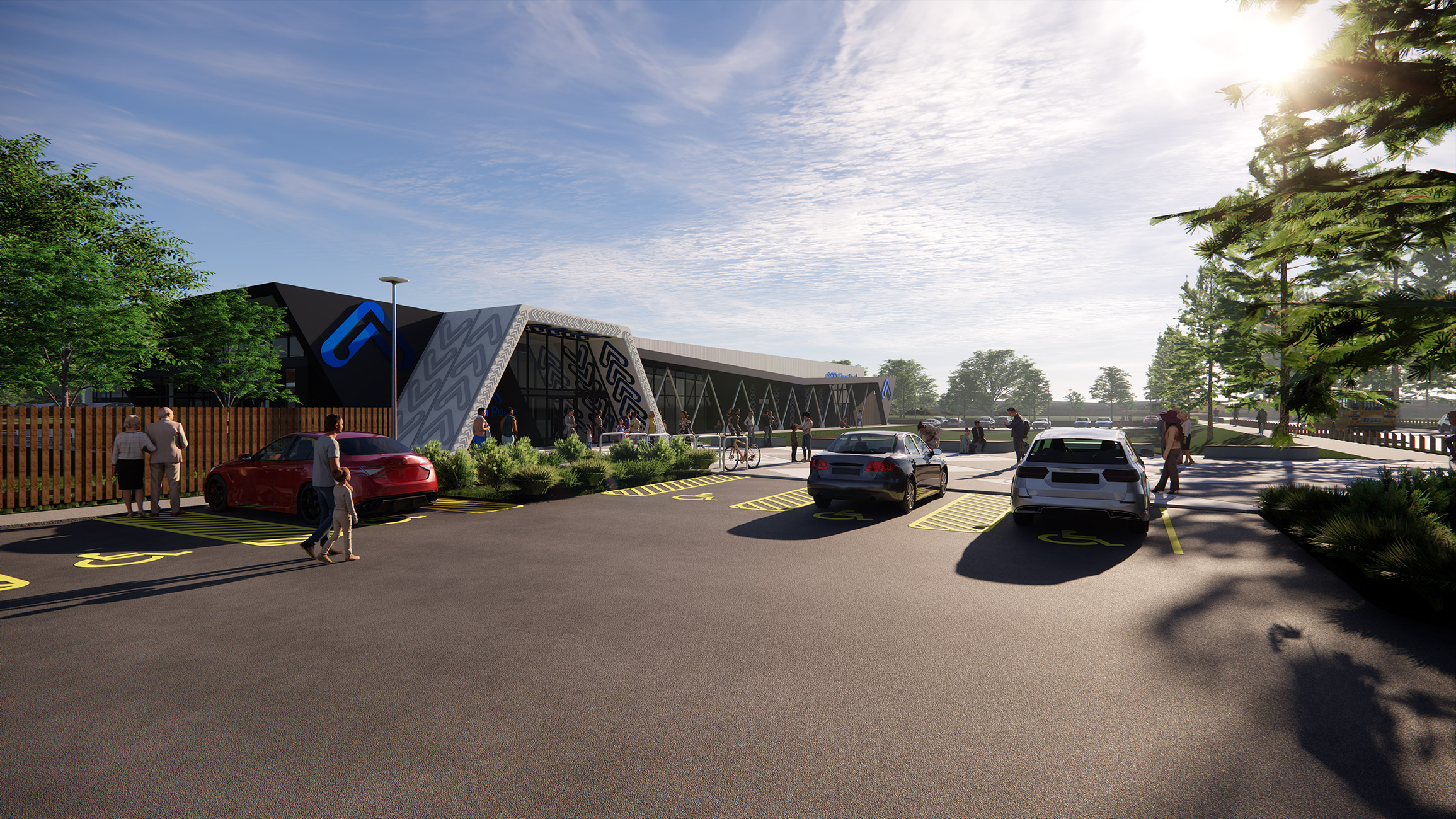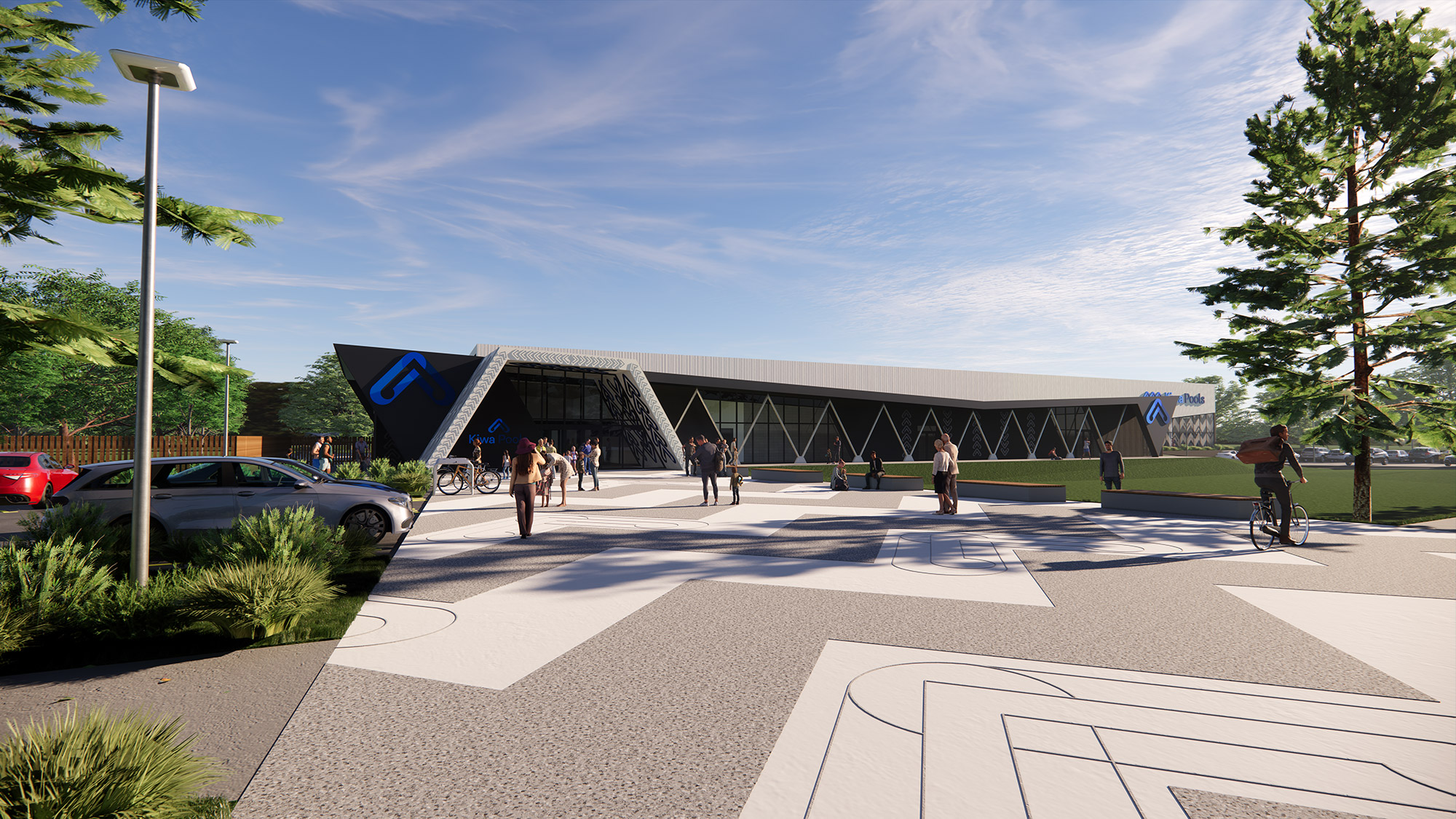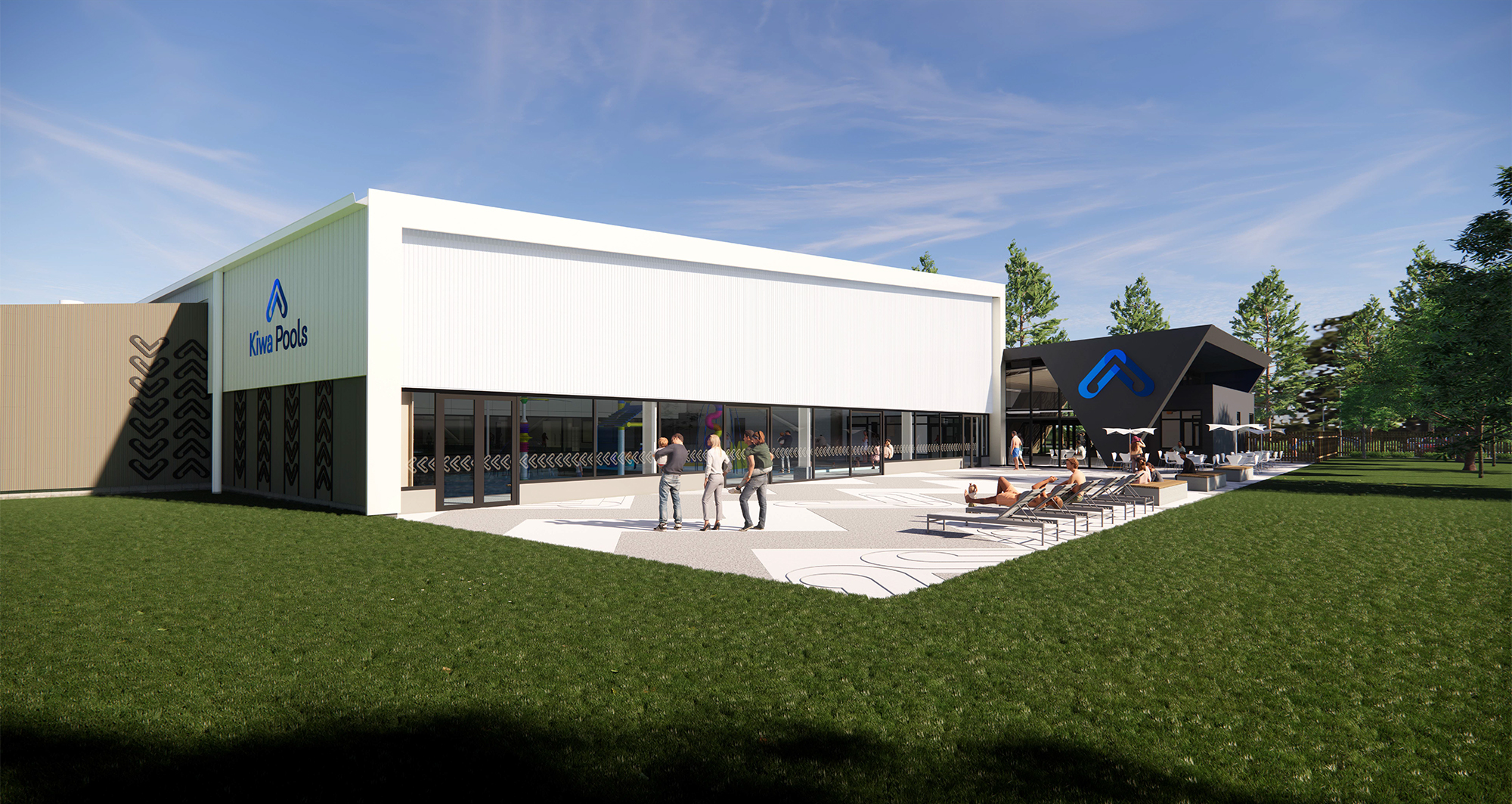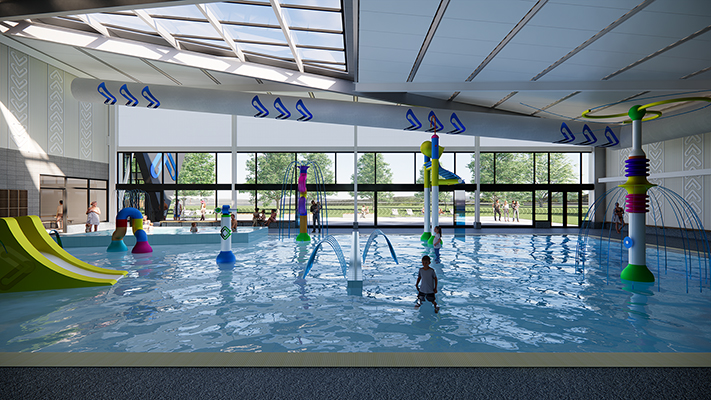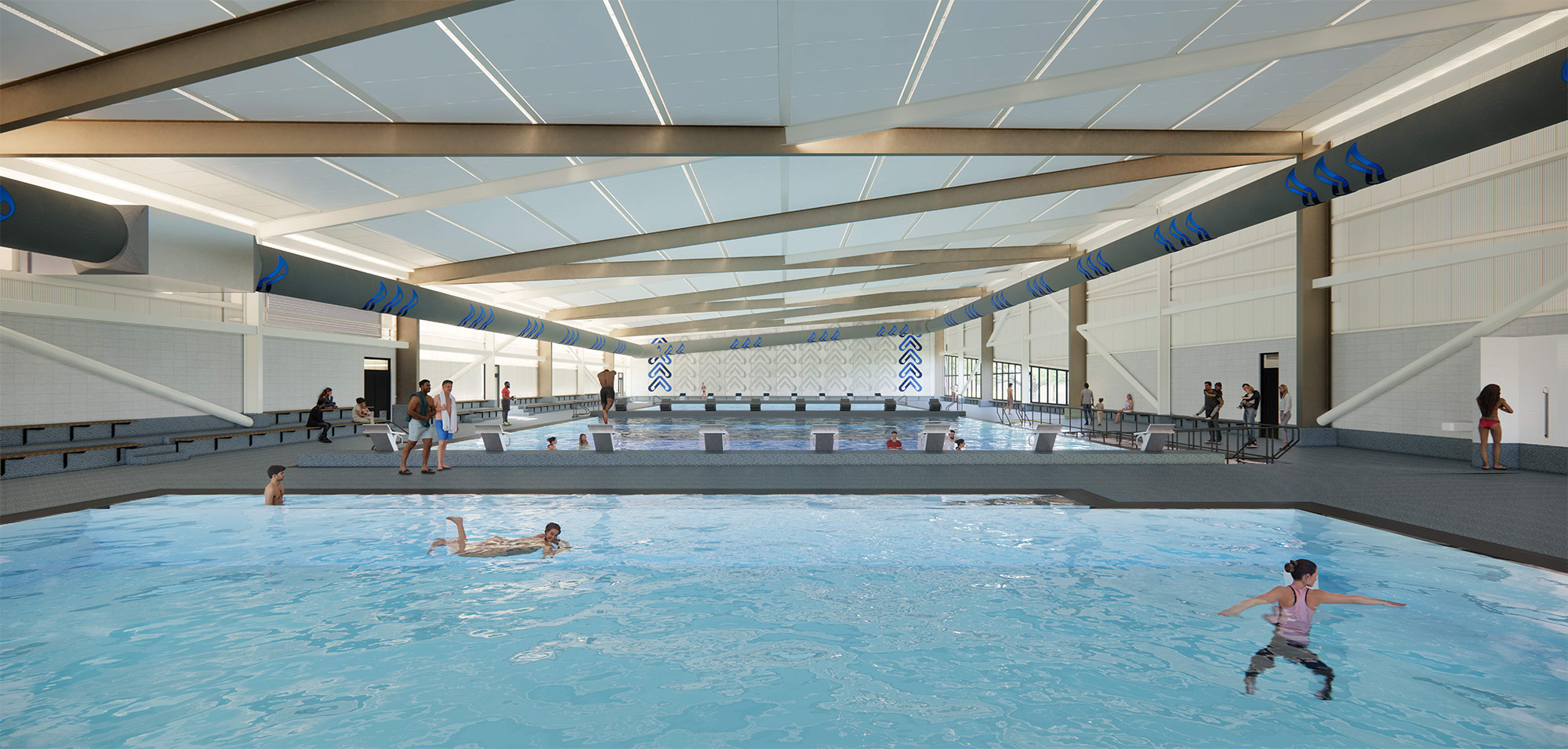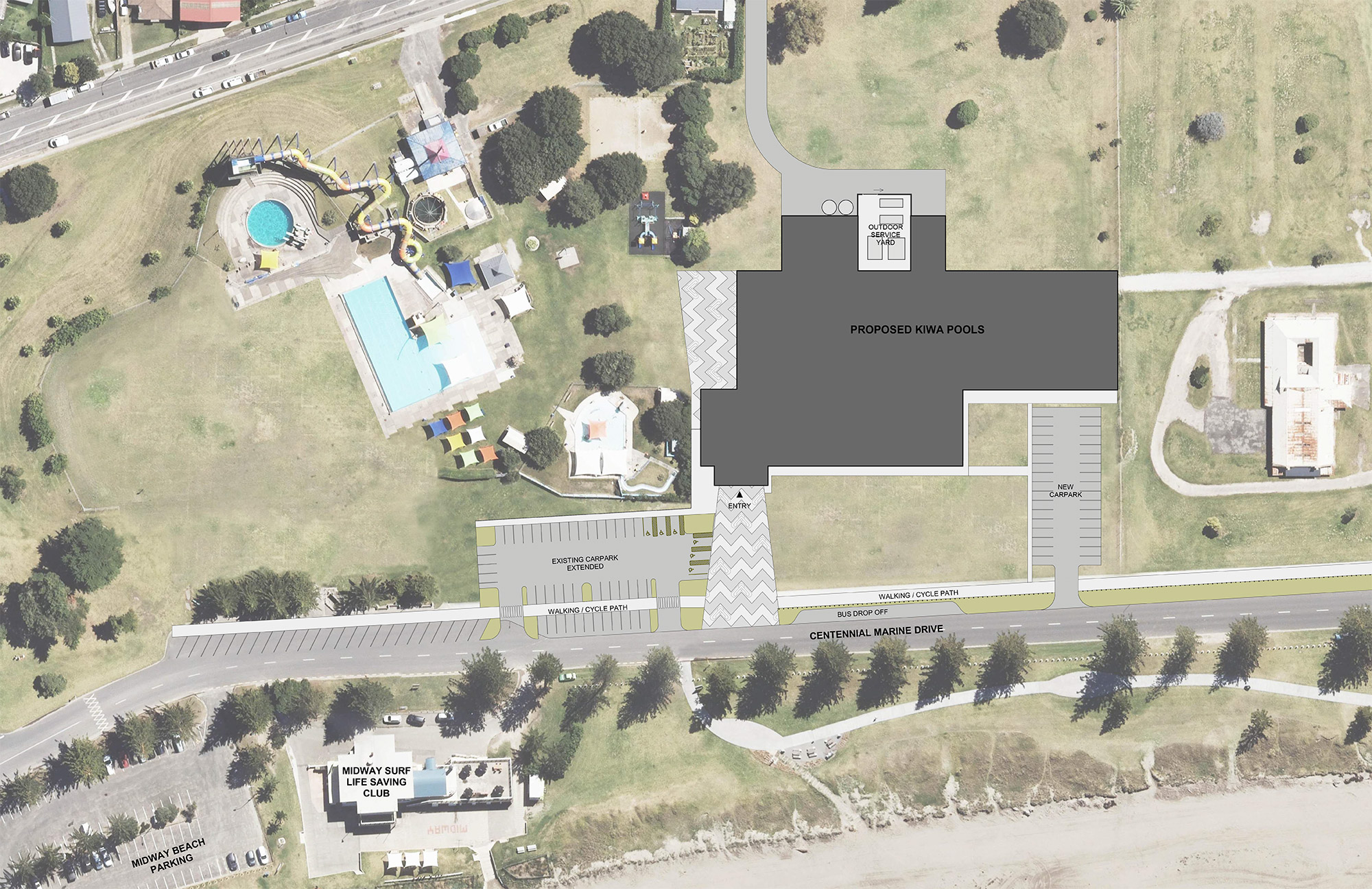
Stage 1 of the Kiwa Pools project to build a modern year-round temperature-controlled aquatic centre was finished and opened 2 September 2023.
Stage 2 is to develop and improve the outdoor play space including basketball courts and to extend the hydroslide use. Project funding is $3.5m external funding and $3m Council funding and is due to start in year 2 of the Three Year Plan 2024-2027.
Demolition of the old 50m covered pool and administration building has been completed, this area will be grassed and landscaped.
Kiwa Pools facilities
Stage 1 of Kiwa Pools build includes these facilities.
| » 50m x 20m multi-use pool with moveable floor* | » Good access for people with disabilities |
| » Leisure and toddler's pool | » Cafe area |
| » Learn-to-swim/hydrotherapy pool | » Event hire room for birthday parties or meetings |
| » hydrotherapy pool suite with hoist** | » Indoor change rooms includes family change areas |
* a moveable floor so more sports can be played. It includes a bulkhead so the pool can be divided in 2.
** hydrotherapy suite includes a purpose-built pool, 2 treadmills and 2 bikes for health professionals to provide water therapy sessions for their clients. The area's self-contained with its own changing room and a hoist can operate from the change area to the pool.
The existing facilities retained as part of the complex include the 33m outdoor pool, outside toddlers pool, dive pool and hydroslide which all open in summer.
The name Kiwa Pools
The name Kiwa Pools was gifted to the complex by partners Ngāi Tāwhiri hapū, reflecting the history and traditions of the people of Tūranganui-a-Kiwa and the story of the land where the complex is located.
Our place
Kiwa Pools sits on the shores of Te Moana Nui a Kiwa, the Pacific Ocean, and remind us of our ancestors that came to settle this land in their sea-faring vessels. It's a nod to the strength and resilience they possessed.
Turanganui-a-Kiwa Gisborne is significant in our nation’s navigation and settlement histories. Close to the place Kiwa Pools stands is a landing spot of the Horouta waka on which Kiwa was the navigator. The captain of the Horouta was Paoa and his sister Hinehākirirangi brought the kumara with her to our region and this began our agricultural heritage.
Kiwa Pools is in the line of sight of Te Kuri a Paoa - Young Nick’s Head, which was the landfall spotted by the watchman aboard the Endeavour.
Turanganui-a-Kiwa is said by some to be the birthplace of our nationhood.
Stage 1 of Kiwa Pools was largely Government funded with a budget of $46 million.

We're grateful for Government funding of $40m for stage 1 of Kiwa Pools as part of it's nationwide Infrastructure Reference Group funding in 2020. Council contributed $5.65m towards the project.
We will apply for external funding of $3.5m for an outdoor area to complete stage 2.
The Olympic Pool redevelopment was a project in our Long Term Plan for many years. In 2017 a business case assessed the level of investment needed. Consultation on preferred options followed as part of the 2018-2028 Long Term Plan.

About the build
Council, Ngāi Tāwhiri and Apollo Projects formed the co-design team with Apollo Projects and managed the overall design and build project.
In March 2021 a change in location for the new pool hall was decided. Relocating the indoor facility alleviated challenges with rebuilding over the top of an existing and aging network-critical sewer pipe. It respects the position of mana whenua with regard to the cultural and spiritual issues associated with human waste.
Sir Derek Lardelli of Lardelli Arts worked with Architecture HDT and Apollo Projects to ensure our cultural narrative was woven into the design of Kiwa Pools.
Q&As about the build
No, the government provided the funding to Gisborne specifically for the construction of Kiwa Pools.
The Olympic Pool renovation project was one of several projects for which Council submitted a funding application to the Infrastructure Reference Group (IRG) for Covid-19 recovery funding.
The IRG received just under 2000 submissions nationwide including another 8 funding applications from Council in areas like flood control and wastewater, as well as the pool redevelopment submission.
Government ministers decided which projects to progress and considered advice from the IRG.
Once a project was selected for funding, the money could only be spent on that project.
1974 - opening of the Gisborne Olympic Pool Complex
1983 - 98m hydroslide added
1992 - BBQ and entertainment areas developed
1994 - toddlers pool slide added
1995 - main pool - canopy structure – commencement of all year use
1996 - spa and hot pools installed
1997 - ‘bulkhead’ pool divider installed in main pool
1999 - alterations to administration block
2002 - new children's playground installed
2002 - major repairs to fix leaks in 50m pool
2007 - added accommodation (8 bunk bed cabins)
2007 - Gisborne earthquake caused some damage to outdoor pools
2008 - Accredited with ‘PoolSafe’ status
2009 - leaking pools repaired (earthquake damage)
2009 - installed 4 designated BBQ areas
2010 - installed new 400kW wood chip boiler for pool water heating (replacing gas boiler)
2010 - Whanau Fun Day event attended to by 2000+ people
2011 - PoolAlone initiated (dealing with unsupervised children at the pool complex)
2012 - renovation of pool canopy structure
2014 - upgraded filtration system to improve water quality. Shade sails and canopy installed.
The Gisborne Olympic Pool Complex is a true community pool; many great fundraising efforts were held in the community and donations were made by various trusts and groups, which greatly assisted Council to establish this facility in 1974.
Like many other public pools in New Zealand, our facility was build in the early 1970s as an outdoor facility, to be used for the summer season only and shut down in winter.
Over the years, the demands for aquatic activities grew and new facilities were added.
Today, over 150,000 visits to the facility are recorded every year.
Kiwa Pools facilities
The moveable floor allows us to futureproof the 50-metre pool for more users.
It can accommodate more sports to be played in the pool and the opportunity to host more events.
It’s a huge advantage for elderly and those with disabilities and gives us more flexibility for different users to be in the pool at the same time.
The moveable floor and moveable bulk head allows recreational use and sporting use in the main pool at the same time.
The movable bulkhead allows the 50m pool to turn into a multipurpose aquatic area so different activities can happen at the same time.
Staff can activate the motorised bulkhead to move from the centre of the pool to the southern end.
It takes about 12 minutes for the bulkhead to complete its journey and create a 50m pool.
The pool is 51.5m long allowing for the 1.5m wide bulkhead to sit at one end without compromising the pool length.
Generally, the pool will be configured as 2 x 25m pools, with the bulkhead in the middle.
We’ve built a community aquatic recreation facility, not an event-based facility. We can still play host to FINA-compliant regional competition swimming, water polo, canoe polo, and national surf lifesaving events.
The pool is designed to be a flexible facility that can support other water based sports that may emerge in the future.
Energy usage for the aquatic facility will be supplemented by $810,000 of solar panels. This was funded through the government's Three Waters’ Better Off Funding.
The solar panels will provide a sustainable energy source for this facility. This will reduce our reliance on non-renewable sources, improve energy resilience and keep operational costs of the new complex as low as possible.
The wood chip heating system will be retained as a back up system.
